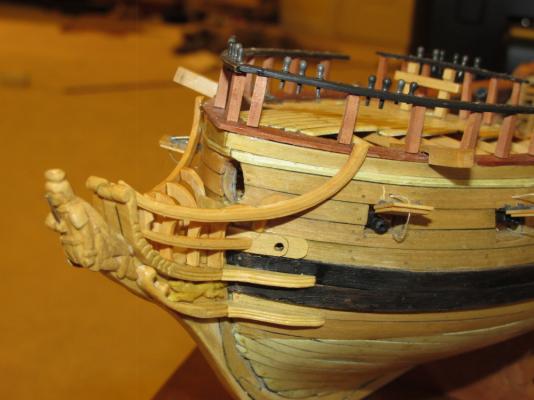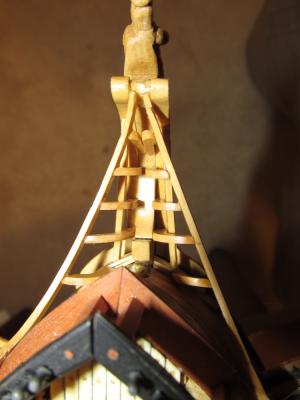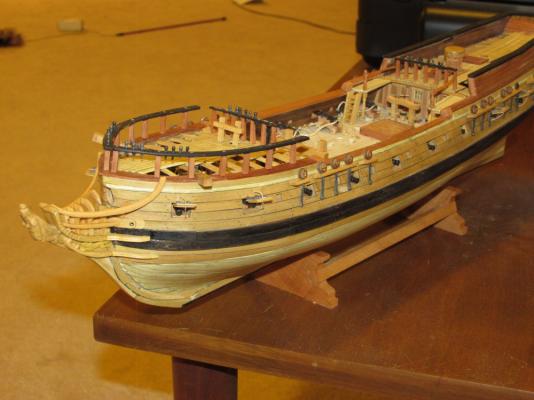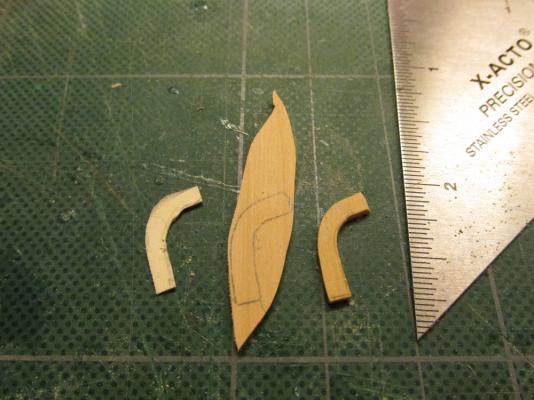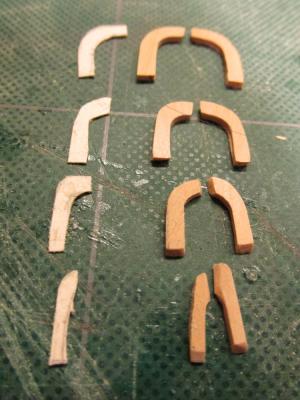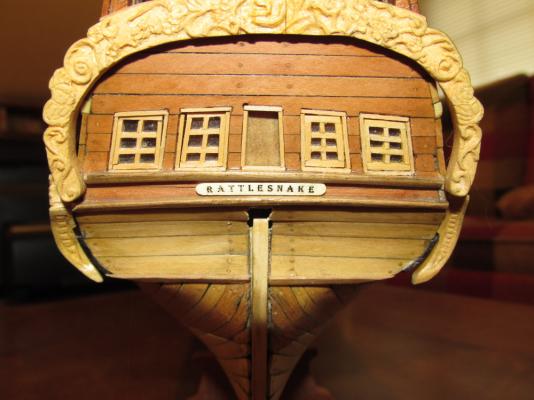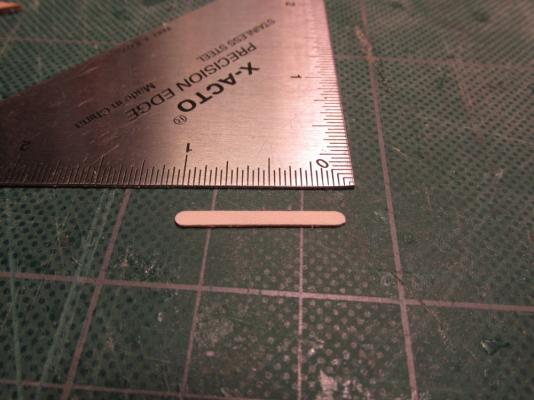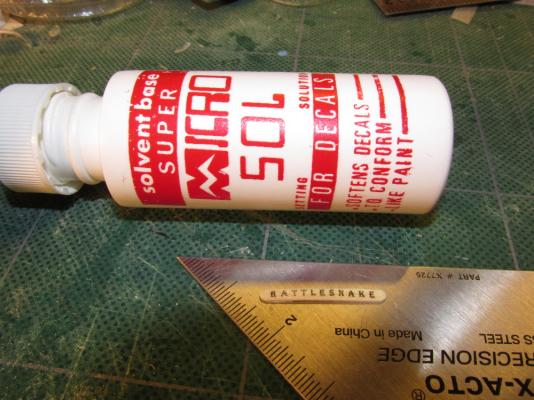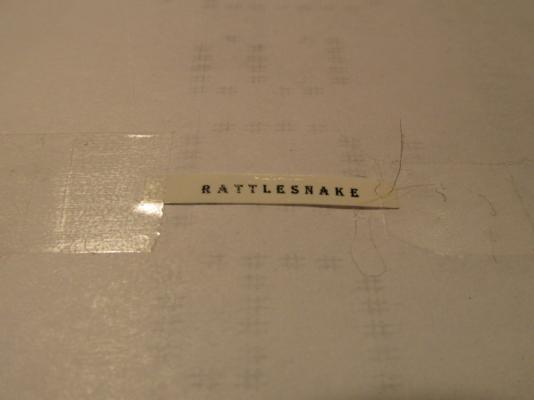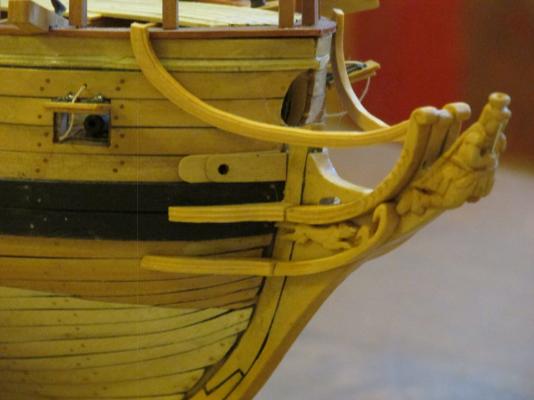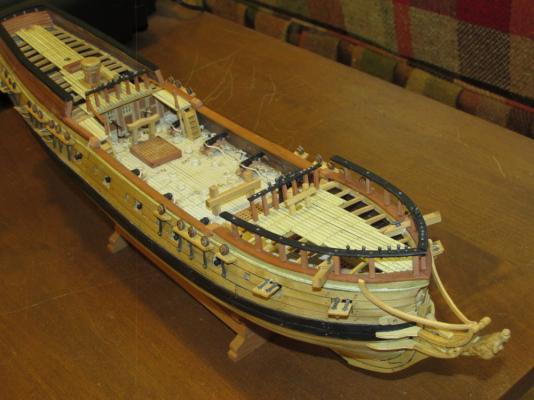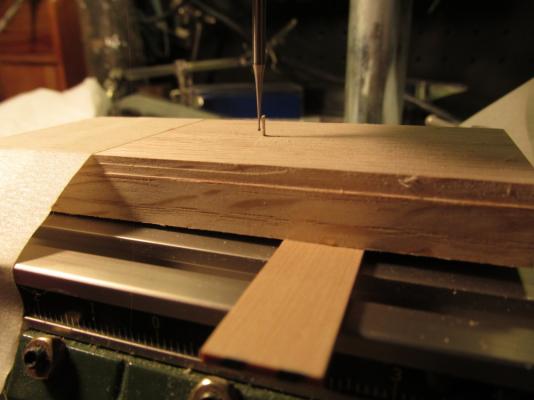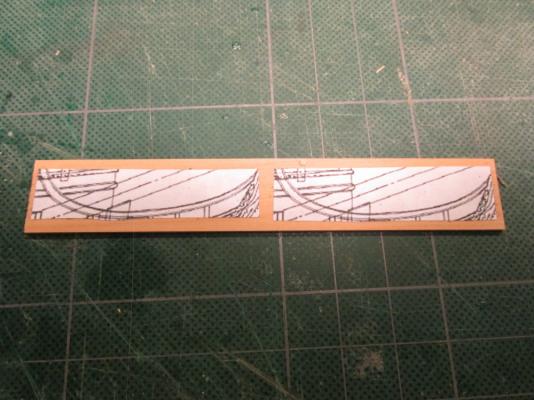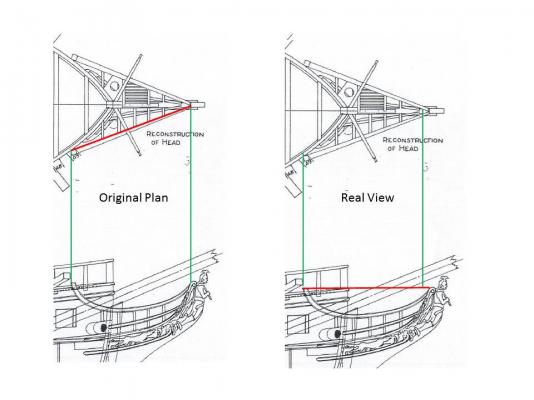-
Posts
2,618 -
Joined
-
Last visited
Content Type
Profiles
Forums
Gallery
Events
Everything posted by JSGerson
-
Then the first of fourteen 1/64” x 1/16” grating slats were installed starting from the center. Following Pasi’s photos, I left a wide space in the center to separate the two gratings.
- 974 replies
-
- rattlesnake
- mamoli
-
(and 1 more)
Tagged with:
-
I couldn't follow Pasi’s build exactly as he built his model because he was working to a larger scale: ¼” – 1’. In particular, he used lap joints for his grating which I was not able to duplicate at my smaller scale. I therefore used butt joints because cutting clean, equally spaced, notches in the cross timbers either completely across or half way for lap joints was beyond my ability and it would not be noticed to the casual observer without a magnifying glass. First, the cross beams made of 1/16” square boxwood were cut to size, fitted, and installed.
- 974 replies
-
- rattlesnake
- mamoli
-
(and 1 more)
Tagged with:
-
As you can tell from my log, I haven't started the masts or yards. In fact I have never made any masts or yards before. I hope you will create your own build log so I can learn from you by following your build and photos.
- 974 replies
-
- rattlesnake
- mamoli
-
(and 1 more)
Tagged with:
-
Welcome aboard! I hope my experiences in building this model helps you to build yours even better than mine. As you may of read early in my build log, this is my first build of this type, so I hope you will forgive any errors I have made along the way. Good luck to you.
- 974 replies
-
- rattlesnake
- mamoli
-
(and 1 more)
Tagged with:
-
I'll be away from building anything this weekend so the earliest you will something will be at least a week away. For the notches, I think, due to the scale, butt joints would work for you. I'm thinking of using 1/32" x 1/16" boxwood (which I will have to mill myself) for the grating and will either notch completely across the cross beam or butt joint. Remember, Pasi was working to 1/4": 1' scale so he had the luxury of larger scale and therefore more space. The seat of ease does have a place for the user's feet. Using the seat, the sailor is facing inward towards the center-line and Pasi did provide a flat surface there. It should be interesting to see how this turns out. What are the "sister blocks" you referred to? Take care Jon
- 974 replies
-
- rattlesnake
- mamoli
-
(and 1 more)
Tagged with:
-
The next step is the construction of the grating and “seat of ease” otherwise known as the “head.” Again, for some reason (I suspect Mr. Hunt was running out time to publish the Practicum and he was building four boats at once), the Practicum is totally silence on its construction. For guidance in this phase, I will fall back to fellow Rattlesnake builder, Pasi Ahopelto’s wonderful but now unavailable build log. Luckily I made a copy of it for reference while he was posting.
- 974 replies
-
- rattlesnake
- mamoli
-
(and 1 more)
Tagged with:
-
- 974 replies
-
- rattlesnake
- mamoli
-
(and 1 more)
Tagged with:
-
Back to the Head Rails Again According to the Practicum, there are four cross timbers per side that need to be constructed and installed. According to everybody else there are five. The one that is missing from the Practicum is the timber coming off the Hawse Reinforcement Boards. Why this was omitted is anyone’s guess. Each one must be custom sized and fitted. First rough measurements were taken to form each cardstock template. The template was then traced onto 1/16” boxwood (In my case, scrap pieces leftover from constructing the head rails). The pieces were cut out with the scroll saw. After filing, sanding, and repeated fittings, the parts were finally formed. They had to be custom fitted due to minute dimensional variances on each side plus the numerous angles the pieces had to fit into. Because the head rails were only glued at the ends with very little glue surface areas, one or two were inadvertently knocked off with the most minor hit. The whole bow structure didn’t become truly stable until all the parts were glued together. In the picture below I show only four sets of timbers. I discovered the fifth one after I started to install them.
- 974 replies
-
- rattlesnake
- mamoli
-
(and 1 more)
Tagged with:
-
You can't print white. That is the problem. The only way using the decal method I can think of is to reverse print: Paint the plaque white On the computer, make an dark opaque background (black or some other dark high contrast color) with white lettering Print the decal When placed on the white plaque the lettering will be white (because the decal will be transparent there) with a dark background I did something like this for a logo which had white areas, on the propeller of the Albatross DVa model. In that case I painted a small white dot on the propeller and put the decal over it. If you try it, let us know how it worked out.
- 974 replies
-
- rattlesnake
- mamoli
-
(and 1 more)
Tagged with:
-
I saved myself from committing error by making a cannon mock-up out of card stock to make sure the cannon would poke through the gun port at the proper height at each gun port location. That little test would have spotted your error by noting that the gun point height was changing as you moved the mock-up around.
-
The lettered nameplate in turn was then glued in place. I knew that ships of that era did that because the actual USS Constitution is done the same way. I chose Holly, a light colored wood, to add some contrast.
- 974 replies
-
- rattlesnake
- mamoli
-
(and 1 more)
Tagged with:
-
Once satisfied, a piece of decal paper was taped over the hole left by a trial cutout because this is where the name was going to print. Once printed, I let the paper sit for a while to insure the ink was properly dry. Then two light coats of decal spray was added and let dry. The decal was then trimmed very close to the lettering. Instead of applying the decal directly to the model, I elected to make a nameplate, a plaque as it were, out of 1/64” Holly and applied the decal to that. A coat of Micro Sol, a decal solvent, was added to ensure adhesion to the wood as well reduce or eliminate the decal edge.
- 974 replies
-
- rattlesnake
- mamoli
-
(and 1 more)
Tagged with:
-
Stern Nameplate This is a slight detour from the head rails due to a discussion on the forum by sport29652 (Eric) on his difficulties of applying lettering to create the ship’s name on his Rattlesnake, I realized that I had the same problem: How does one get the name on the model? Eric tried dry transfer (rub on) lettering with satisfactory results, but whether he was satisfied or not, I don’t know. His work surface was larger than mine because I had added some horizontal molding across the transom. Getting lettering straight with proper kerning (spacing), justification, not to mention choosing proper font and sizing is no easy task on a plain, white, flat surface, like paper. Doing this on a wood surface, restricted space and on a model boat is not easy. In my case, I had to rule it out due to the small confined space on my model. A second choice was vinyl lettering. It gives the illusion of raise lettering. The problem here is that the choice of size and fonts is very restricted especially with very small letters. My lettering needed to be about 2mm. I took a third route: homemade decals. The range of fonts is huge and size is not a problem, plus the computer can adjust spacing, justification, and kerning. All one has to do is print it to the proper size on decal paper, spray the decal coating on, let dry, and apply. Here is how I did it. I chose a font that approximated the font used by Model Shipways. Mamoli had a metal part with the stern windows, name, and carvings. Harold Hahn’s drawings didn't show any name. I typed in the name in Word, doubled the kerning to add space between the letters, and gave it a slight curve baseline. This was printed on paper and check for size.
- 974 replies
-
- rattlesnake
- mamoli
-
(and 1 more)
Tagged with:
-
Thanks. On a change of subjects, did you add the "RATTLESNAKE" name to the stern and if so how? If not are you planning to, and how?
- 974 replies
-
- rattlesnake
- mamoli
-
(and 1 more)
Tagged with:
-
Once the molding was made, the backside of the rail was sanded until the stem end tapered as shown on Hahn’s drawing. I didn’t want to make the tapered end too thin because I was afraid it would become too fragile; so only about .01” was removed. A notch was added where the rails meet the deck and everything was then glued into place.
- 974 replies
-
- rattlesnake
- mamoli
-
(and 1 more)
Tagged with:
-
Based on the Hahn plans I made the molding cut narrower and shallower than what the Practicum showed. I believe Practicum’s were larger was because of the way I did it versus the Xacto knife method Bob Hunt used.
- 974 replies
-
- rattlesnake
- mamoli
-
(and 1 more)
Tagged with:
-
The rails have a molding a little different than the cheeks. This subtle difference required that my pseudo router rig be modified. The ball bit was changed to a trapezoidal bit because a square cut was required on each edge. Because the isn’t any mechanism on the rotary tool stand or the X-Y table to minutely adjust the height of the cutting bit, the fixed wedge was changed to a sliding wedge to make those adjustments by moving the work surface vertically a relatively short distance. Using the fixed wedge setup and moving the X-Y table would not have worked to do this because a restrictor pin was required. The pin restricted the depth the bit could cut horizontally into the wood. The X-Y table adjusted the pin relative to the bit without affecting the height of the bit. Hopefully the diagram and photo below will make this clear.
- 974 replies
-
- rattlesnake
- mamoli
-
(and 1 more)
Tagged with:
-
The stretched view was then printed and compared with the original reduced plan to ensure the height sizes matched. Remember, I only stretched the image horizontally; the vertical dimensions did not change. In my case, I had to reduce the printed image a little bit. Between the scanning and printing the overall size of the image was not maintained. Two final prints (one for each side) were made for templates which were then rubber cemented onto a piece of ¾” x 1/16” boxwood. The boxwood piece was not part of the original wood package but was sent to me from HobbyMill when I was making the two interior bulkheads some time back. The Practicum stated to use 1/16” stock, but did not specify where it came from.
- 974 replies
-
- rattlesnake
- mamoli
-
(and 1 more)
Tagged with:
-
Back to the Head Rails When viewed from the side, the head rail forms a sweeping arc from the bow to the tip of the stem. From the top it is straight and tapers toward the stem. None of the plans from Harold Hahn, Mamoli, or Model Shipways shows the head’s true full scale shape. All of them either show a top down view or an elevation (side) view. The rail is foreshortened in the elevation view. The Practicum tries to address this by having you reduce Mr. Hahn’s plan 90% instead of the 72% or 75% as before in order to increase the size so the template would properly fit. My 3 in 1 home copier/scanner/printer cannot do reductions or enlargements so that option was out. Even if I could, I wouldn't do it this way. Yes, you may get the proper length, but now the height would be larger as well. While I was still employed (up until this time last year) and still had access to my company’s copier, I made a number of piece-meal legal size copies of the reduced version of Han’s plans so that I could cut them up to make templates without ruining the original reduction version. Using one of those copies I scanned the bow section into the computer. On the scanned image I drew a line (red) on the rail in the top view. This was the true length of the rail. This line was copied, rotated till it was horizontal and placed on a second copy of the scanned image. The second scanned image was then stretched horizontally until the elevated view length of the rail matched the horizontal red line. Now I had a true length of the rail without any vertical distortion to be used as a template. You can see how much longer the rail is when compared to the green reference lines.
- 974 replies
-
- rattlesnake
- mamoli
-
(and 1 more)
Tagged with:
-
In pre-computer days, I made a lot of forms for use in my office, I drew every line by hand and lettered all the text with dry-transfers (rub-on). Multiple copies were then made on the Xerox machine. I know from experience how difficult it can be to get the proper kerning (spacing between lettering), letter angles, as well as proper line justification on nice flat smooth paper. To do this on a wood surface, in a cramped space that curve, on a model boat to boot, is no easy task. My hat is off to you. In my case, I think I might try making a decal. Because I included two molding strips that go across the transom, the lettering would have to go in between them. Applying dry transfers here would be very difficult if not impossible. First I would plan to print the name on a piece of paper to check for size, placement, font selection, etc. and then create the decal. The results are yet to be determined.
-
I don't mind a bit, in fact I encourage it. I may be working on a tricky part now, the head rails, but as I think I mentioned before, I am very apprehensive when it comes time to work on the masts, yards, and rigging. So I am following a lot of people, including you Martin, on this part of the model construction. I have the luxury of time being unemployed/retired (depending whom I'm talking to) to work pursue my hobby more than an hour a day. So take your time Martin just so long as you document it, so I can learn from it. 8-) Jon
- 974 replies
-
- rattlesnake
- mamoli
-
(and 1 more)
Tagged with:
About us
Modelshipworld - Advancing Ship Modeling through Research
SSL Secured
Your security is important for us so this Website is SSL-Secured
NRG Mailing Address
Nautical Research Guild
237 South Lincoln Street
Westmont IL, 60559-1917
Model Ship World ® and the MSW logo are Registered Trademarks, and belong to the Nautical Research Guild (United States Patent and Trademark Office: No. 6,929,264 & No. 6,929,274, registered Dec. 20, 2022)
Helpful Links
About the NRG
If you enjoy building ship models that are historically accurate as well as beautiful, then The Nautical Research Guild (NRG) is just right for you.
The Guild is a non-profit educational organization whose mission is to “Advance Ship Modeling Through Research”. We provide support to our members in their efforts to raise the quality of their model ships.
The Nautical Research Guild has published our world-renowned quarterly magazine, The Nautical Research Journal, since 1955. The pages of the Journal are full of articles by accomplished ship modelers who show you how they create those exquisite details on their models, and by maritime historians who show you the correct details to build. The Journal is available in both print and digital editions. Go to the NRG web site (www.thenrg.org) to download a complimentary digital copy of the Journal. The NRG also publishes plan sets, books and compilations of back issues of the Journal and the former Ships in Scale and Model Ship Builder magazines.






